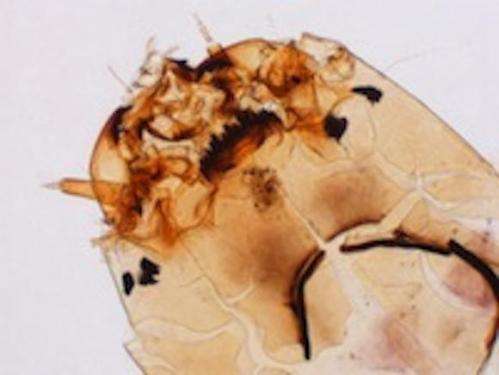Insect and river health improves after tobacco agriculture removed

(Phys.org) —New research has linked deformed insects to pesticide pollution from intensive tobacco cultivation around the Oven's River in Victoria, and found once the industry ceased operating the river's health improved.
The study shows that using insects as indicators of environmental health may provide new techniques that are useful for monitoring agriculture to keep it sustainable, and that these methods may actually be cheaper than traditional chemical assays.
Led by by Dr Vincent Pettigrove and Bryant Gagliardi from the Centre for Aquatic Pollution and Identification Management (CAPIM) at The University of Melbourne, the work is published in the current issue of the journal Agriculture, Ecosystems and Environment.
The researchers observed deformities in the freshwater insect, the chironomid or 'non-biting midge' and found the occurrence of physically deformed mouthparts in the aquatic insects (including missing, additional and fused teeth) indicated the presence of pollutants in the river system including the now banned insecticide DDT.
Dr Pettigrove said once the tobacco crops were removed, the chironomid deformities declined, indicating that environmental recovery was possible and that the insect-based techniques used would be helpful in monitoring agricultural practices to keep them sustainable.
"We have seen that land-managers can make decisions about how they use their land that positively impact aquatic ecosystems because current farming practices in the area are having a lesser impact on the Ovens River," he said.
"The improvement in health of the chiromonid is significant as an indicator of river health as they are found in every type of freshwater environment worldwide and are an important food resource for fish."
The original study was conducted by Dr Pettigrove for an EPA Victoria study conducted in 1988 and 1989 when tobacco cultivation was widespread and again in 2010 after tobacco cultivation ceased in the region.
During 1988/89 chironomids collected from the Ovens River, dams and billabongs in the vicinity of tobacco farms had a higher incidence of deformities than those collected from areas upstream and more than 10 km downstream of the tobacco region. ??The 2010 study was conducted to determine whether there was still evidence of pesticide pollution in the former tobacco region in the absence of intensive tobacco cultivation.
They found there were significantly less deformities in this region in 2010 compared to those present in 1988/89. Therefore, the removal of this intensive agriculture has resulted in a recovery in neighbouring aquatic ecosystems.
More information: www.sciencedirect.com/science/ … ii/S0167880913001813
Provided by University of Melbourne














